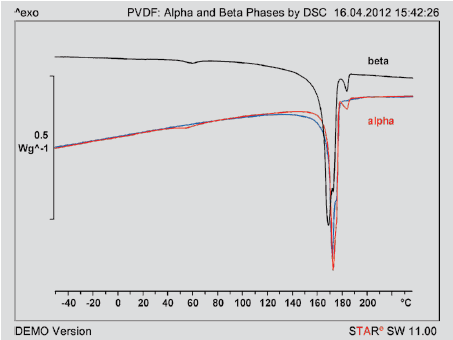Structure, Properties and Phase Transitions of Melt-Spun Polyvinylidene Fluoride Fibers
 Figure 1: DSC heating runs measured at 5 K/min for fibers with α- (red) and β-phases (black). The blue curve shows the second heating run of a sample that had been slowly cooled from the melt.
Figure 1: DSC heating runs measured at 5 K/min for fibers with α- (red) and β-phases (black). The blue curve shows the second heating run of a sample that had been slowly cooled from the melt.Conventional DSC, temperature-modulated DSC (TMDSC) and DMA measurements were used to study the phase transitions of crystalline phases in melt-spun PVDF fibers. The results are compared with those obtained from wide-angle X-ray diffraction. The information about the phase transitions can be used to adjust the crystalline β-phase content in fibers and optimize piezoelectric properties.
Introduction
Polyvinylidene fluoride (PVDF) is a fluoropolymer with excellent chemical stability. The polymer is semicrystalline and can form different crystalline phases (so-called α-, β-, γ- and δ-phases). The molecules of this polymer have a large dipole moment perpendicular to the polymer chain. Depending on the crystal structure, this gives rise to different electrical properties that are utilized in many technical applications such as for actuators and sensors [1].
PVDF films are manufactured by melt blowing and PVDF fibers in melt spinning processes. Depending on the production process, up to four different crystal phases occur. The α-, γ- and δ-phases are non-polar. The β-phase exhibits piezoelectric properties. This phase is formed under mechanical tensile stress or in strong electrical fields and is responsible for the ferroelectric and piezoelectric properties of the materials.
The phases and their transitions can be characterized by differential scanning calorimetry (DSC), dynamic mechanical analysis (DMA) and wide-angle X-ray diffraction (WAXD). These methods are employed to investigate the formation of different phases and in particular the β-phase. The results can be used to optimize production and finishing processes.
Thermal analysis
DSC
Conventional DSC measurements were performed at heating rates of 2, 5, and 10 K/min in the temperature range –90 °C to 250 °C using a METTLER TOLEDO DSC 1. Figure 1 displays the DSC curves of PVDF with exclusively α- or β-phases measured at 5 K/min. The figure also shows the heating curve (blue) of a sample that had been slowly cooled from the melt...
Download the full text of this article below.
Summary
Figure 5 presents an overview of the possible structural phase transitions in melt-spun PVDF fibers. It includes the temperature-dependent transitions as well as effects of mechanical stress that occur during cold stretching of the fibers. This study shows that tensile stress produces a β-phase in PVDF fibers. Using the combination of temperature-modulated DSC and wide-angle X-ray diffraction, it was possible to elucidate the different phase transitions in the PVDF. The DMA measurements help one to understand the mechanical relaxation. This information can be used to achieve specific formation of the β-phase and thus to optimize the piezoelectric effect.
A detailed description of the phase behavior of the PVDF fiber can be found in our publication [3].
Structure, Properties and Phase Transitions of Melt-Spun Polyvinylidene Fluoride Fibers | Thermal Analysis Application No. UC355 | Application published in METTLER TOLEDO Thermal Analysis UserCom 35